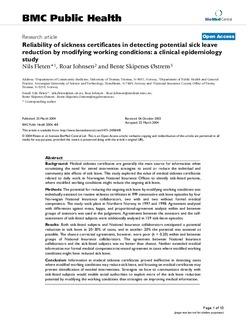| dc.contributor.author | Fleten, Nils | |
| dc.contributor.author | Johnsen, Roar | |
| dc.contributor.author | Ostrem, BS | |
| dc.contributor.author | Østrem, Bente Skipenes | |
| dc.date.accessioned | 2015-09-11T11:59:50Z | |
| dc.date.accessioned | 2015-09-17T09:01:56Z | |
| dc.date.available | 2015-09-11T11:59:50Z | |
| dc.date.available | 2015-09-17T09:01:56Z | |
| dc.date.issued | 2004 | |
| dc.identifier.citation | BMC Public Health 2004, 4 | nb_NO |
| dc.identifier.issn | 1471-2458 | |
| dc.identifier.uri | http://hdl.handle.net/11250/300449 | |
| dc.description.abstract | Background:
Medical sickness certificates are generally the main source for information when scrutinizing the need for aimed intervention strategies to avoid or reduce the individual and community side effects of sick leave. This study explored the value of medical sickness certificates related to daily work in Norwegian National Insurance Offices to identify sick-listed persons, where modified working conditions might reduce the ongoing sick leave.
Methods:
The potential for reducing the ongoing sick leave by modifying working conditions was individually assessed on routine sickness certificates in 999 consecutive sick leave episodes by four Norwegian National Insurance collaborators, two with and two without formal medical competence. The study took place in Northern Norway in 1997 and 1998. Agreement analysed with differences against mean, kappa, and proportional-agreement analysis within and between groups of assessors was used in the judgement. Agreements between the assessors and the self-assessment of sick-listed subjects were additionally analysed in 159 sick-leave episodes.
Results:
Both sick-listed subjects and National Insurance collaborators anticipated a potential reduction in sick leave in 20–30% of cases, and in another 20% the potential was assessed as possible. The chance corrected agreements, however, were poor (k < 0.20) within and between groups of National Insurance collaborators. The agreement between National Insurance collaborators and the sick-listed subjects was no better than chance. Neither extended medical information nor formal medical competence increased agreement in cases where modified working conditions might have reduced sick leave.
Conclusion:
Information in medical sickness certificates proved ineffective in detecting cases where modified working conditions may reduce sick leave, and focusing on medical certificates may prevent identification of needed interventions. Strategies on how to communicate directly with sick-listed subjects would enable social authorities to exploit more of the sick leave reduction potential by modifying the working conditions than strategies on improving medical information. | nb_NO |
| dc.language.iso | eng | nb_NO |
| dc.publisher | BioMed Central | nb_NO |
| dc.title | Reliability of sickness certificates in detecting potential sick leave reduction by modifying working conditions: a clinical epidemiology study | nb_NO |
| dc.type | Journal article | nb_NO |
| dc.type | Peer reviewed | en_GB |
| dc.date.updated | 2015-09-11T11:59:50Z | |
| dc.source.volume | 4 | nb_NO |
| dc.source.journal | BMC Public Health | nb_NO |
| dc.identifier.doi | 10.1186/1471-2458-4-8 | |
| dc.identifier.cristin | 426098 | |
| dc.description.localcode | © 2004 Fleten et al; licensee BioMed Central Ltd. This is an Open Access article: verbatim copying and redistribution of this article are permitted in all media for any purpose, provided this notice is preserved along with the article's original URL. | nb_NO |
